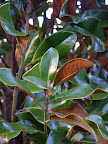 Photo Curtesy of UMass Extension
Photo Curtesy of UMass ExtensionRecently I have come to realize that my biggest problems are generally self created by ignoring the warning signs when they were small problems. My Pieris japonica var. yakushimanum ‘Prelude’ has been hit hard by the Andromeda Lace Bug Stephanitis takeyai for two years in a row, my treatment plan has been limited to spraying horticultural oil just prior to June 1st in my Massachusetts garden and then to be frank I become lazy, forgetful, and disinterested by midsummer and follow up by doing nothing.
 Winter is the time I make promises to my self about better gardening practices with this in mind I decided to learn more about the Andromeda Lace Bug Stephanitis takeyai (not Lace Wing the beneficial insect) with the hopes of creating an aggressive pesticide free plan to save my Pieris japonica, and I thought I would share what I have learned, my plan of action, and update you throughout the 2008 season with the plants condition.
Winter is the time I make promises to my self about better gardening practices with this in mind I decided to learn more about the Andromeda Lace Bug Stephanitis takeyai (not Lace Wing the beneficial insect) with the hopes of creating an aggressive pesticide free plan to save my Pieris japonica, and I thought I would share what I have learned, my plan of action, and update you throughout the 2008 season with the plants condition.The Andromeda Lace Bug Stephanitis takeyai is a non native insect from Japan that was thought to have been brought over on a plant. Stephanitis takeyai has adapted very well to my zone 7a environment and according to the University of Massachusetts Extension there will be as many as three to four generations of this insect in one season(May though September). One of the things that makes combating this insect so difficult is the mother lays the eggs inside the tissue of the underside of the leaf and then protects the egg further by sealing it with a shellac like substance.
 Both the nymphs and the adults feed on the Pieris japonica by piercing the leaf and sucking on the plant fluid, this causes the leaves to look yellowed as in my photo. The appearance of damage to the top of the leaf can look similar to damage caused by a mite attack but the underside will be very telling as the Andromeda Lace Bug will reveal the lace bug, nymph, excrement and the shellac like substance. In the photo of my Pieris japonica leaf all of that “bug juice” can be wiped off the leaf leaving only some rather large puncture holes.
Both the nymphs and the adults feed on the Pieris japonica by piercing the leaf and sucking on the plant fluid, this causes the leaves to look yellowed as in my photo. The appearance of damage to the top of the leaf can look similar to damage caused by a mite attack but the underside will be very telling as the Andromeda Lace Bug will reveal the lace bug, nymph, excrement and the shellac like substance. In the photo of my Pieris japonica leaf all of that “bug juice” can be wiped off the leaf leaving only some rather large puncture holes.My plan of action is to begin spraying the undersides of all leaves but particularly those closest to the ground with horticultural oil or insecticidal soap (undecided which might do a better job) to eliminate as many nymphs as possible and repeat this once every two weeks eliminating new generations of eggs until the end of September.




2 comments:
Yikes - this leaf does not look to be in good shape. I do the same thing with making promises to myself to do all manner of things in the garden to counteract powdery mildew. I start off well, but then something happens and I get off track.
I hope you are able to get this under control soon.
kate,
powdery mildew is not a big issue in my garden partly due to my environment and partly to plant selection. I did how ever once have a senior gardener respond to a GW post who was from the south east, she swore by applying anti-descants (Wilt Pruf) in the early spring to protect plants such as roses, spring perennials, ect from black spot and powdery mildew. I have never tried it but there is a core of common sense in the suggestion. Katy
Post a Comment